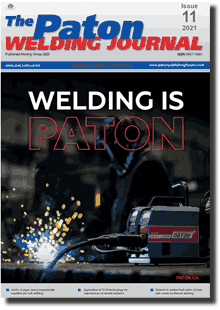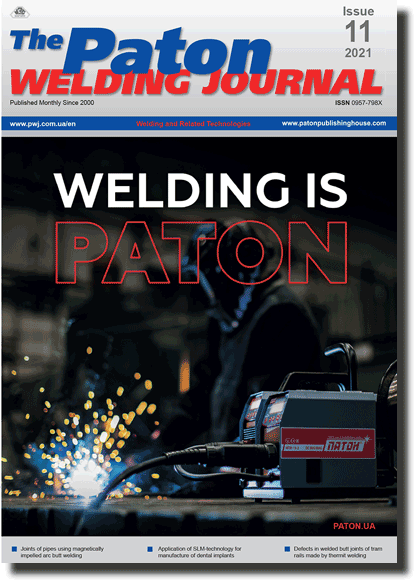| 2021 №11 (04) |
DOI of Article 10.37434/tpwj2021.11.05 |
2021 №11 (06) |

The Paton Welding Journal, 2021, #11, 29-33 pages
Investigation of the causes for appearance of defects in welded butt joints of tram rails made by thermit welding
E. Turyk1, I.O. Ryabtsev2, M. Lomozik1, K. Krasnovskyi1
1Lucasiewicz Research Network-Institute of Welding 44-100, Gliwicc, 16-18 Bl. Czeslava, Poland. E-mail: is@is.gliwice.pl
2E.O. Paton Electric Welding Institute of the NASU. 11 Kazymyr Malevych Str., 03150, Kyiv, Ukraine. E-mail: ryabtsev39@gmail.com
Abstract
The results of investigations of the causes for fatigue fracture of rail butt joints on two new tram tracks, made by thermit welding by two organizations are presented. Control analysis of the chemical composition and mechanical properties of the rail material; analysis of the chemical composition of the welds, macro- and microscopic investigations of the weld, HAZ and base metal, and hardness studies in these zones were performed. It was found that pore accumulation and isolated microcracks in the metal of welds are the potential cause for cracking. Violations of the technological process of thermit welding of the tram tracks were determined, which lead to appearance of these defects. The detected defects are the result of the following factors, associated with failure to meet the standard requirements on thermit welding of tram tracks and of the system of ensuring the quality of welding operations, namely violation of welding technology and insufficient control at the respective stages of the production process.
Keywords: thermit welding, tram tracks, fatigue cracks, porosity; microcracks, quality assurance system
Received 16.09.2021
Accepted: 29.11.2021
References
1. PN-EN 16771:2017–01: Railway applications — Infrastructure — Aluminothermic welding of grooved rails.2. PN-EN 14730-1:2017–06: Railway applications — Track — Aluminothermic welding of rails, Pt 1: Approval of welding processes.
3. DSTU EN ІSO 3834-2:2019: Quality requirements for fusion welding of metallic materials, Pt 2: Comprehensive quality requirements
4. PN-EN 14811:2019–06: Railway applications. Track. Special purpose rail. Grooved rails and associated construction profiles.
5. Lawrence, F.V., Chen, Y-R., Cyre, J.P. (2014) Improving the fatigue resistance of thermite railroad rail weldments. http:// fcp.mechse.illinois.edu/files/2014/07/Lawrence-presentation. pdf
6. Thermit SRZ/SRZ L50/SRE welding process for grooved rails. https://www.elektro-thermit.de/fileadmin/et/user_upload/ PDF/Produktbrosch%C3%BCren/SRZ_SRE_DEF.pdf
7. DSTU EN 10204:2017: Metallic products — Types of inspection documents.
8. PN-EN 14730-2:2006: Railway applications — Track — Aluminothermic welding of rails, Pt 2: Qualification of aluminothermic welders, approval of contractors and acceptance of welds.
9. (2010) Code of Practice for the THERMIT — Quick Welding Procedure SoWoS. Elektro-Thermit GmbH & Co KG.
10. (2019) Instrukcja spawania szyn termitem Id-5. PKP Polskie Linie Kolejowe S.A.
11. Code of Practice for the THERMIT — Quick Welding Procedure SkV. Elektro-Thermit GmbH & Co KG, 2010. https:// www.thermit.com.au/media-centre/technical-information/ PI_8.5.1-296_TA_TS-Code-of-Practice-SkV-Elite-Welding-Procedure.pdf.
12. Elektro-Thermit. Technology of aluminothermic welding of rails with short time of heating (SkV, SkV-L 50, SkV-L 75). https://docplayer.com/27763010-Elektro-termit-tehnologiya-alyuminotermitnoy-svarki-relsov-s-korotkim-vremenem-podogreva-skv-skv-l-50-skv-l-75.html.
Suggested Citation
E. Turyk, I.O. Ryabtsev, M. Lomozik, K. Krasnovskyi (2021) Investigation of the causes for appearance of defects in welded butt joints of tram rails made by thermit welding. The Paton Welding J., 11, 29-33.The cost of subscription/purchase order journals or individual articles
| Journal/Currency | Annual Set | 1 issue printed |
1 issue |
one article |
| TPWJ/USD | 384 $ | 32 $ | 26 $ | 13 $ |
| TPWJ/EUR | 348 € | 29 € | 24 € | 12 € |
| TPWJ/UAH | 7200 UAH | 600 UAH | 600 UAH | 280 UAH |
| AS/UAH | 1800 UAH | 300 UAH | 300 UAH | 150 UAH |
| AS/USD | 192 $ | 32 $ | 26 $ | 13 $ |
| AS/EUR | 180 € | 30 € | 25 € | 12 € |
| SEM/UAH | 1200 UAH | 300 UAH | 300 UAH | 150 UAH |
| SEM/USD | 128 $ | 32 $ | 26 $ | 13 $ |
| SEM/EUR | 120 € | 30 € | 25 € | 12 € |
| TDNK/UAH | 1200 UAH | 300 UAH | 300 UAH | 150 UAH |
| TDNK/USD | 128 $ | 32 $ | 26 $ | 13 $ |
| TDNK/EUR | 120 € | 30 € | 25 € | 15 € |
AS = «Automatic Welding» - 6 issues per year;
TPWJ = «PATON WELDING JOURNAL» - 12 issues per year;
SEM = «Electrometallurgy Today» - 4 issues per year;
TDNK = «Technical Diagnostics and Non-Destructive Testing» - 4 issues per year.


